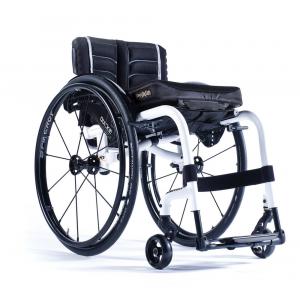Rigid Wheelchairs are made up of a one-piece frame. Due to their overall design, and materials, rigid wheelchairs are extremely lightweight.
A folding wheelchair comes with a foldable feature, which involves folding the wheelchair seat and components into a smaller shape, which provides significant storage space savings and may be conveniently stored in the trunk of a vehicle.
Do you feel confused between selecting folding and rigid wheelchairs? Here are some points to consider while choosing between Folding and Rigid Wheelchair
One of the most common questions that come up frequently is Folding versus Rigid wheelchairs. Let’s discuss both sides today.
1. Configuration:
Folding Wheelchair- They have a traditional cross-brace that collapses in half by pressing the sides together. With a scissor brace, chairs can be folded from the front and back, rather than from the sides.
Rigid Wheelchair- Rigid wheelchairs were developed as modifications to sports wheelchairs. The lighter weight and structure enable users to push with much less effort. Rigid wheelchairs are often divided into two types- the monotube, which uses a single tube to provide a softer ride, and the box frame, which includes a second support bar to enable more energy conservation.
2. Weight
Materials are simply one thing to consider when it comes to the overall weight of your chair. The weight of the wheelchair should be the most important factor to be considered while looking for a wheelchair. Before buying it, make sure you are aware of the components available in that weight. Frame materials should be chosen based on their weight, strength, and durability.
Titanium has a high strength-to-weight ratio, which means it gives a lighter frame weight and has a longer service life, due to its resistance to bending damage and corrosion.
Aluminium is more economical. Greater steps have been made in order to increase the strength to produce a lighter weight frame. It will require an additional coating to achieve the same level of corrosion resistance as Titanium.
Carbon Fiber is the most recent addition to the wheelchair market which is a lightweight, durable material that resists corrosion. They are more expensive to manufacture due to the difficulty in shaping them. It lacks the same resistance as other materials and therefore has a higher risk of damage if dropped.
3. Style of Frames
Rigid manual wheelchair frames come in two different frames. One has a “monotube,” which is a single continuous tube that leaves the chair’s bottom open and makes it easier to bring closer and across the body to transfer into the car. Naturally, the frame’s weight is lowered with less tubing. Titanium can be used in a monotube style that can provide a softer ride, but it may also take energy from the push, which may result in energy loss. Others enjoy this “drive” because it is more pleasant, or it has a favourable effect on reducing tone or pain when propelling the chair.
Rigid frames normally feature a “fixed front end,” which means it does not move out of the way for standing transfers; rather, search for a single side “flip-up” footplate that opens the chair’s front region for transfers. Once the footplate is lifted, the leg rests may swing away in some circumstances. It’s crucial to remember this and test this frame to ensure it’ll work for you. “Quick release axles,” like folding frames, make it simple to remove the wheels. Canes that “fold-down” to make the frame smaller may usually be ordered back to help in transferring the frame into a smaller boot or vehicle.
Now you might be aware of the different factors to consider while looking for a rigid and folding wheelchair. The experts at Cura360 can save you weeks of debating the pros and cons of different models. Cura360 is a one-stop-shop for all DME products and services.
Cura360 provides a variety of mobility options in several famous tourist destinations around the United States.

 1-833-207-3433
1-833-207-3433
